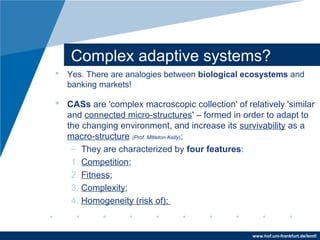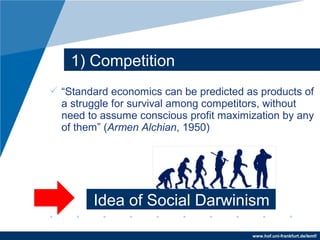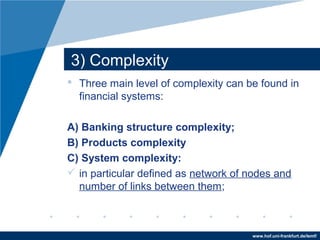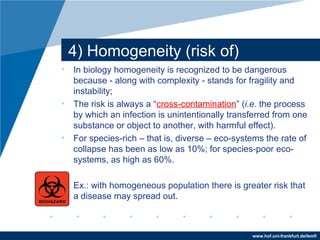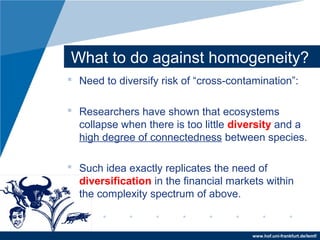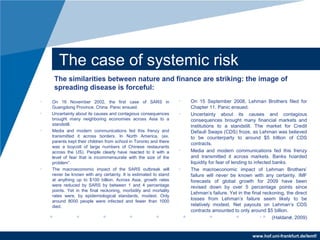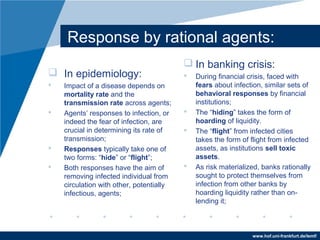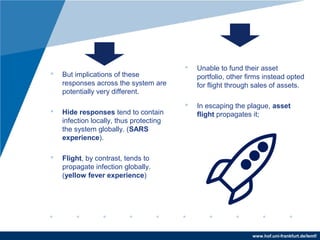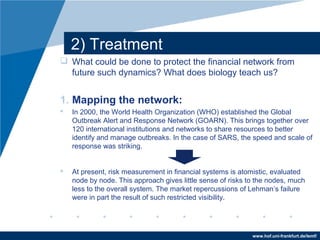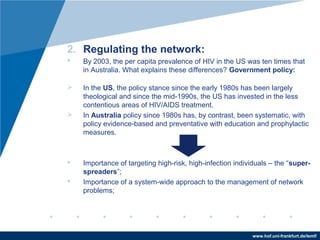Banking & Biology
- 1. www.hof.uni-frankfurt.de/lemf/ “Banking & Biology” . Analyzing financial systems as complex adaptive ecosystems in case of Systemic Risk Luca Amorello PhD Forum: 21 March 2014
- 2. www.hof.uni-frankfurt.de/lemf/ Banking & Biology ? What do the financial system and a tropical rainforest have in common? 1. Both are complex adaptive systems; 2. Comparing them would allow to identify and analyze financial structural vulnerabilities; 3. Important conclusions about how to best manage the financial network;
- 3. www.hof.uni-frankfurt.de/lemf/ Complex adaptive systems? ? Yes. There are analogies between biological ecosystems and banking markets! ? CASs are 'complex macroscopic collection' of relatively 'similar and connected micro-structures' – formed in order to adapt to the changing environment, and increase its survivability as a macro-structure (Prof. Mitleton-Kelly); – They are characterized by four features: 1. Competition; 2. Fitness; 3. Complexity; 4. Homogeneity (risk of);
- 4. www.hof.uni-frankfurt.de/lemf/ ? “Standard economics can be predicted as products of a struggle for survival among competitors, without need to assume conscious profit maximization by any of them” (Armen Alchian, 1950) 1) Competition Idea of Social Darwinism
- 5. www.hof.uni-frankfurt.de/lemf/ ? In Darwinian theory means adaptation to the environment. ? A competitive environment favors firms that adapt to a specific environment. In particular: “To determine whether a market is working well from an overall social standpoint, one has to understand the environment and the business behavior that best enables a firm to survive” (R. Posner) 2) Fitness:
- 6. www.hof.uni-frankfurt.de/lemf/ 3) Complexity ? Three main level of complexity can be found in financial systems: A) Banking structure complexity; B) Products complexity C) System complexity: ? in particular defined as network of nodes and number of links between them;
- 7. www.hof.uni-frankfurt.de/lemf/ 4) Homogeneity (risk of) ? In biology homogeneity is recognized to be dangerous because - along with complexity - stands for fragility and instability; ? The risk is always a “cross-contamination” (i.e. the process by which an infection is unintentionally transferred from one substance or object to another, with harmful effect). ? For species-rich – that is, diverse – eco-systems the rate of collapse has been as low as 10%; for species-poor eco- systems, as high as 60%. ? Ex.: with homogeneous population there is greater risk that a disease may spread out.
- 8. www.hof.uni-frankfurt.de/lemf/ What to do against homogeneity? ? Need to diversify risk of “cross-contamination”: ? Researchers have shown that ecosystems collapse when there is too little diversity and a high degree of connectedness between species. ? Such idea exactly replicates the need of diversification in the financial markets within the complexity spectrum of above.
- 9. www.hof.uni-frankfurt.de/lemf/ But if banking systems replicate the main features of ecosystems... ? ...can we analize financial structural criticalities under a “biological” point of view? ? ...can we learn from biology how to deal with them? ? ...what are the consequences in the regulation of financial markets?
- 10. www.hof.uni-frankfurt.de/lemf/ The case of systemic risk ? On 16 November 2002, the first case of SARS in Guangdong Province. China. Panic ensued. ? Uncertainty about its causes and contagious consequences brought many neighboring economies across Asia to a standstill. ? Media and modern communications fed this frenzy and transmitted it across borders. In North America, (ex. parents kept their children from school in Toronto and there was a boycott of large numbers of Chinese restaurants across the US). People clearly have reacted to it with a level of fear that is incommensurate with the size of the problem”. ? The macroeconomic impact of the SARS outbreak will never be known with any certainty. It is estimated to stand at anything up to $100 billion. Across Asia, growth rates were reduced by SARS by between 1 and 4 percentage points. Yet in the final reckoning, morbidity and mortality rates were, by epidemiological standards, modest. Only around 8000 people were infected and fewer than 1000 died. ? On 15 September 2008, Lehman Brothers filed for Chapter 11. Panic ensued. ? Uncertainty about its causes and contagious consequences brought many financial markets and institutions to a standstill. The market for Credit Default Swaps (CDS) froze, as Lehman was believed to be counterparty to around $5 trillion of CDS contracts. ? Media and modern communications fed this frenzy and transmitted it across markets. Banks hoarded liquidity for fear of lending to infected banks. ? The macroeconomic impact of Lehman Brothers’ failure will never be known with any certainty. IMF forecasts of global growth for 2009 have been revised down by over 5 percentage points since Lehman’s failure. Yet in the final reckoning, the direct losses from Lehman’s failure seem likely to be relatively modest. Net payouts on Lehman’s CDS contracts amounted to only around $5 billion. ? (Haldane, 2009) The similarities between nature and finance are striking: the image of spreading disease is forceful:
- 11. www.hof.uni-frankfurt.de/lemf/ ? Both events were manifestations of the behavior under stress of a complex, adaptive network: ? Complex because these networks were a cat’s-cradle of interconnections, financial and non-financial. ? Adaptive because behavior in these networks was driven by interactions between optimizing, but confused, agents. ? Both are Robust-yet-fragile systems, susceptible to a loss of confidence in the key hubs and with rapid international transmission of disturbances.
- 12. www.hof.uni-frankfurt.de/lemf/ 1) Diagnosis ? Banking Crisis as Epidemics: ? Homogeneity: diversification strategies by individual firms generated a lack of diversity across the system as a whole. ? Complexity: during this century financial system exhibits greater complexity. ? Connectivity: Beyond a certain range, connections serve as shock- amplifiers. ? Instability: complexity plus homogeneity spelt fragility. ? The system acts not as a mutual insurance device but as a mutual incendiary device.
- 13. www.hof.uni-frankfurt.de/lemf/ Response by rational agents: ? In epidemiology: ? Impact of a disease depends on mortality rate and the transmission rate across agents; ? Agents’ responses to infection, or indeed the fear of infection, are crucial in determining its rate of transmission; ? Responses typically take one of two forms: “hide” or “flight”; ? Both responses have the aim of removing infected individual from circulation with other, potentially infectious, agents; ? In banking crisis: ? During financial crisis, faced with fears about infection, similar sets of behavioral responses by financial institutions; ? The “hiding” takes the form of hoarding of liquidity. ? The “flight” from infected cities takes the form of flight from infected assets, as institutions sell toxic assets. ? As risk materialized, banks rationally sought to protect themselves from infection from other banks by hoarding liquidity rather than on- lending it;
- 14. www.hof.uni-frankfurt.de/lemf/ ? Unable to fund their asset portfolio, other firms instead opted for flight through sales of assets. ? In escaping the plague, asset flight propagates it; ? But implications of these responses across the system are potentially very different. ? Hide responses tend to contain infection locally, thus protecting the system globally. (SARS experience). ? Flight, by contrast, tends to propagate infection globally. (yellow fever experience)
- 15. www.hof.uni-frankfurt.de/lemf/ 2) Treatment ? What could be done to protect the financial network from future such dynamics? What does biology teach us? 1. Mapping the network: ? In 2000, the World Health Organization (WHO) established the Global Outbreak Alert and Response Network (GOARN). This brings together over 120 international institutions and networks to share resources to better identify and manage outbreaks. In the case of SARS, the speed and scale of response was striking. ? At present, risk measurement in financial systems is atomistic, evaluated node by node. This approach gives little sense of risks to the nodes, much less to the overall system. The market repercussions of Lehman’s failure were in part the result of such restricted visibility.
- 16. www.hof.uni-frankfurt.de/lemf/ 2. Regulating the network: ? By 2003, the per capita prevalence of HIV in the US was ten times that in Australia. What explains these differences? Government policy: ? In the US, the policy stance since the early 1980s has been largely theological and since the mid-1990s, the US has invested in the less contentious areas of HIV/AIDS treatment. ? In Australia policy since 1980s has, by contrast, been systematic, with policy evidence-based and preventative with education and prophylactic measures. ? Importance of targeting high-risk, high-infection individuals – the “super- spreaders”; ? Importance of a system-wide approach to the management of network problems;
- 17. www.hof.uni-frankfurt.de/lemf/ ? Policy prescriptions: ? There is essentially no relationship between banks’ systemic importance and their Basel capital ratios. ? No targeted vaccination of the super-spreaders of financial contagion. The super-spreaders may historically have had lower capital buffers; ? Basel vaccinated the naturally immune at the expense of the contagious: “the celibate were inoculated, the promiscuous intoxicated”; ? Need plans to introduce tighter regulatory requirements for systemic institutions; ? Need to improve network robustness and diversity (ex. Glass- Steagall Act).
- 18. www.hof.uni-frankfurt.de/lemf/ What we learned: The similarities between ecosystems and financial markets are striking: financial systems are complex adaptive networks and we may use biology and biological tools to analyze the behaviors of interconnected agents. Diagnosis: ? Homogeneity and complexity beyond a certain point lead to instability; ? Rational agents respond by “hiding” or “flying”, that means “hoarding” or “selling” capital and assets. ? Such choice may affect the entire system by spreading the infection . Treatment: ? Mapping the network: need to build an unified structure able to collect, process and communicate data; ? Regulating the network: need to identify “super-spreader” and preventive measure; vaccination trough different capital requirements; ? Restructuring the network. For any suggestion, inquiry or criticism: do not hesitate to contact me: lucamorale@gmail.com Biology of epidemics can provide some insights that can help policymakers to deal with financial criticalities and systemic risk :



